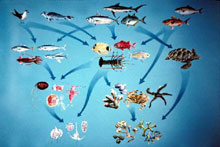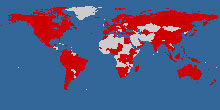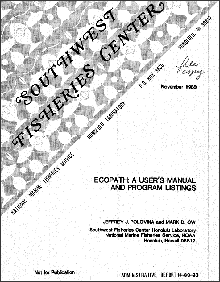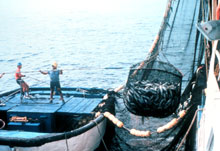ECOPATH Modeling: Precursor to an Ecosystem Approach to Fisheries Management
Modeling to Understand Marine Ecosystems

This schematic representation of a marine ecosystem food web illustrates some of the interrelationships or eclogical pathways between the species that make up the community. Applying the ECOPATH model helps ecologists better understand the significance of those relationships to the overall ecosystem. Click image for larger view.
In the early 1980s, NOAA scientist Dr. Jeffrey Polovina and his colleagues at the National Marine Fisheries Service, Honolulu Laboratory, developed an innovative marine ecosystem model known as ECOPATH. Named to convey its focus on ecological pathways, it was the first model to apply a type of statistics called “path analysis” to the field of marine ecology. The model’s simplicity and its ability to accurately identify ecological relationships have revolutionized scientists’ ability worldwide to understand complex marine ecosystems.
Ecologists use path models to estimate the direction and strength of all factors that influence the way ecosystems function. The original ECOPATH model described energy flow through the coral reef food web. Starting at the top of the food chain, scientists tracked tiger sharks to determine what and how much they consumed. They extended their observations to other members of the food chain all the way down to algae, simple plants known as primary producers in the parlance of ecological science. Path models allow scientists to calculate direct and indirect effects from a multitude of ecosystem components, providing them with the first means to model an ecosystem’s true complexity.

Schools of colorful pennantfish, pyramid and milletseed butterflyfish on the French Frigate Shoals atoll, Northwestern Hawaiian Islands. This coral reef ecosystem was the subject of the orginal ECOPATH model. Click image for larger view and image credit.
ECOPATH was also a product of a multi-agency research initiative in the Northwestern Hawaiian Islands, where scientists applied path analysis to the French Frigate Shoals atoll. While numerous NOAA field studies had been done in this region to collect information on specific organisms, creating the ECOPATH model allowed scientists to understand the complex biological inter-relationships among all the living things that made up this insular community, from the simplest marine plants to the largest ocean predators.
Model Simplicity Leads to Widespread Use
ECOPATH was truly innovative for its ability to represent complex ecosystems using a small amount of computing power. Other approaches to ecosystem modeling during this period relied on a vast set of mathematical equations and a large amount of information to work properly. Dr. Polovina's approach used a novel set of simplified equations and smaller data requirements to obtain an accurate picture of the entire ecosystem. These simplified requirements are what allowed ECOPATH to be applied to so many marine ecosystems.

Between November 2003 and December 2006 nearly 3,400 scientists from 145 countries have registered to use the most recent versions of ECOPATH, making it the most commonly used ecosystem model. Click image for larger view.
Ecosystem scientists outside of NOAA have championed and advanced ECOPATH beyond the first version of the model, especially professors Daniel Pauly, Villy Christensen, and Carl Walters of the University of British Columbia. They incorporated in ECOPATH a dynamic simulation model called ECOSIM, which tracks ecosystem changes over time, and ECOSPACE, which add a geographical dimension. Today, ECOPATH is, by far, the most common approach to ecosystem modeling. Between November 2003 and December 2006, nearly 3,400 users worldwide registered to use it. ECOPATH has been cited in hundreds of scientific papers and books as well as those that discuss the newer ecological models ECOSIM and ECOSPACE which use Dr. Polovina's master equations as their mathematical foundation.
Unlocking the Mysteries of Ecosystem Dynamics

User's manual for the original ECOPATH model. Quoting from the manual: "The ECOPATH model…estimates a biomass budget for the marine ecosystem in a static situation under the assumption that the ecosystem is at equilibrium conditions." Click image for larger view.
The renowned ecosystem modeler, R.E. Ulanowicz summed up the revolutionary impact of the ECOPATH on the marine ecological community in a 1993 paper from the conference proceedings of the International Center for Living Aquatic Resources Management (now called WorldFish Center) when he wrote: "The heavens were opened to us by Galileo and his telescope, the world of microbes by Pasteur and his microscope. It may not be much of an exaggeration to say that the realm of ecosystems is being opened to us by Polovina, Pauly, and Christensen."
Widespread Uses for ECOPATH

The ECOPATH model enables fisheries managers and ecologists to determine the effects of commercial fishing on the entire marine ecosystem, not just a single species. Click image for larger view.
At the time Dr. Polovina created it, the ECOPATH model represented one of NOAA's first steps toward an ecosystem approach to fisheries management. But it was also apparent that the model could be used in different ways, such as studying the effects of fishing on an ecosystem, evaluating ecosystem recovery after a major disturbances like oil spills, determining where to locate marine protected areas, and modeling the effects of changing climate. Ecologists soon discovered they could apply the ECOPATH model to virtually any ecosystem if they had measurements of the ecological pathways of that ecosystem.
Today, when ecologists talk about the structure of ecosystems, they use terms like "top down" or "bottom up" to characterize dominant portions of the food web revealed from ECOPATH analyses. The newest versions of ECOPATH models are important tools that provide insights into the structure and dynamics of marine ecosystems. They offer another example of NOAA leadership to advance the ecosystem approach to fisheries and other marine resource management and stewardship. And the ECOPATH suite of software is free, putting it easily in the hands of ecology students and researchers who might not otherwise be able to use it.










